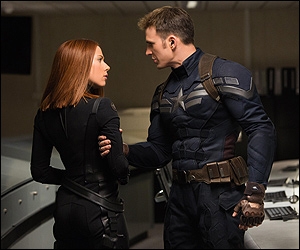Supervising Location Manager James Lin on Captain America 2 and California filming
Marvel made the unusual step of bringing big-budget film production to California for its comic-book sequel Captain America: The Winter Soldier. Supervising Location Manager James Lin talks about the challenges of the shoot and California’s filmmaking future.
Captain America: The Winter Soldier filmed both on location and in studio facilities in California. Stage work took place mostly at Raleigh Manhattan Beach Studios, while exterior sets were built in LA County.
 Lin arranged to film the movie’s opening sequence on the Sea Launch Commander, a private vessel used for scientific research and satellite launches. Getting authorisation to film here was a longwinded process as the ship’s launch capabilities officially classified it as a ‘War Vessel’, meaning the production team had to submit themselves to a comprehensive security review.
Lin arranged to film the movie’s opening sequence on the Sea Launch Commander, a private vessel used for scientific research and satellite launches. Getting authorisation to film here was a longwinded process as the ship’s launch capabilities officially classified it as a ‘War Vessel’, meaning the production team had to submit themselves to a comprehensive security review.
“My location team had to be cleared through multiple security checks,” Lin recalls, “Then we had to clear every crew member who boarded the ship as well via thorough background checks. As the ship had never had filming before on it, I had to ‘educate’ the crew in terms of what a film crew required to get our work done, so there was a lot of preparation to just get our crew on to the ship.”
The Captain America sequel has become one of only a handful of big-budget movies to film on location in California over the last few years. The state offers a base 20% filming incentive for larger productions but has an annual fund of only USD100 million – compared to USD420 million in New York – and doesn’t support productions on the scale of Captain America.
I know firsthand of seasoned union and non-union technicians who have moved to where the tax incentives are.
James Lin, Supervising Location Manager
Authorities are now lobbying for improvements to the incentive programme in an effort being spearheaded by Ken Ziffren, the city's so-called ‘film tsar’ and head of the Mayor of Los Angeles’ Entertainment Industry and Production Office.
Lin acknowledges that California faces stiff competition from elsewhere in the US and he has watched an exodus of skilled technicians to states where big-budget feature production is thriving.
 “I know firsthand of seasoned union and non-union technicians who have moved to where the tax incentives are,” he observes.
“I know firsthand of seasoned union and non-union technicians who have moved to where the tax incentives are,” he observes.
“With their departure they take all the expenditures they do on a daily/weekly/yearly basis for granted, for example eating in a local restaurant, sleeping in a hotel or renting an apartment or house, taking their family to the new environment [and] getting a rental car for the family. These costs are all spent locally where that individual is. Tax incentives and credits are to offset the costs associated of getting a capable crew to these locations.”
Nonetheless, Lin is optimistic for the future of production in California and believes it’s just a matter of time before the filming incentive programme is expanded. He explains that Los Angeles was chosen for the Captain America sequel for its aesthetics and the strength of the local crew base.
“The ease with which we can take a project from vision to reality [in California] with the various qualified trades and technicians is amazing,” Lin explains: “We have the amazing sunny weather for more than 80% of the year and one of the most varied looks within a state that can cover a plethora of geographical locations from the mountains to the dessert, to the beaches and the downtown skyline.”
Lin has gained extensive experience of filming around the world since getting his production break on Brett Ratner’s 2002 thriller Red Dragon, a remake of the 80s thriller Manhunter that first introduced cinema audiences to the infamous serial killer Hannibal Lector.
 In the decade since he has worked on features including M Night Shyamalan’s Lady in the Water, the Twilight franchise and Fast & Furious 5.
In the decade since he has worked on features including M Night Shyamalan’s Lady in the Water, the Twilight franchise and Fast & Furious 5.
Filming Washington, DC, and Cleveland, Ohio, for Captain America: The Winter Soldier posed a new set of logistical issues. Although limited filming took place in Washington, the city’s notorious bureaucracy convinced the production team to take advantage of Ohio’s base 25% filming incentive and largely double Cleveland for Washington. Marvel had previous experience in the city, having doubled Cleveland for New York for the finale of the first Avengers movie.
“We closed a major artery leading into downtown Cleveland for ten days straight for filming of 1st and 2nd Unit sequences,” Lin offers: “There are so many challenging locations, but each one presents its own unique puzzle, which I enjoy trying to figure out with my team.”
(Images: Marvel)
Related Posts
Directory - United States of America (see more…)
Comments
Not Logged in
You must be logged in to post a comment
There are no comments